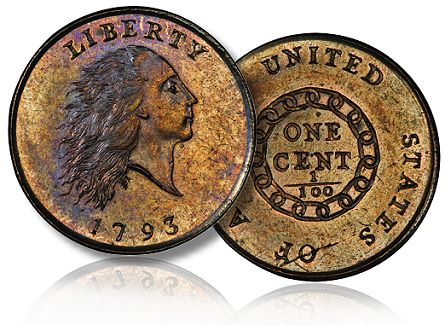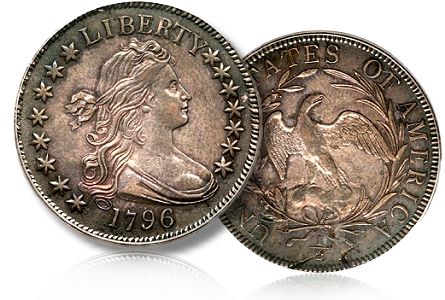By Mark Ferguson – www.MFrarecoins.com ……
While dealing in coins for more than 40 years, I’ve observed that the most experienced and sophisticated collectors and investors are drawn to early American coins – the very first coins produced by our country. These are the coins minted between 1793, the first year of regular-issue United States coins, and the mid-1830s, when steam presses were first introduced at the Mint – “early” U.S. coins were struck by hand on screw presses.
American coins of this early era can be broken down into three categories: copper, silver and gold coinage. While advanced collectors of each of these areas use a very technical approach in collecting – by die variety – a more universal approach is to build a collection/investment by design type.
This method consists of collecting one example of each major design type per denomination. Here’s a list of the denominations of early American coins and the major design types of each denomination:
 COPPER COINS
COPPER COINS
Half Cents
- Liberty Cap, Head Facing Left – 1793
- Liberty Cap, Head Facing Right – 1794-1797
- Draped Bust – 1800-1808
- Classic Head – 1809-1836
- Braided Hair – 1840-1857
Large Cents
- Flowing Hair, Chain Reverse – 1793
- Flowing Hair, Wreath Reverse – 1793
- Liberty Cap – 1793-1796
- Draped Bust – 1796-1807
- Classic Head – 1808-1814
- Liberty Head, Matron Head – 1816-1839
- Liberty Head, Braided Hair – 1839-1857
SILVER COINS
Half Dimes
- Flowing Hair – 1794-1795
- Draped Bust, Small Eagle Reverse – 1796-1797
- Draped Bust, Heraldic Eagle Reverse – 1800-1805
- Capped Bust – 1829-1837
- Draped Bust, Small Eagle Reverse – 1796-1797
- Draped Bust, Heraldic Eagle Reverse – 1798-1807
- Capped Bust – 1809-1837
Quarters
- Draped Bust, Small Eagle Reverse – 1796
- Draped Bust, Heraldic Eagle – 1804-1807
- Capped Bust, Large Diameter – 1815-1828
- Capped Bust, Reduced Diameter – 1831-1838
Half Dollars
- Flowing Hair – 1794-1795
- Draped Bust, Small Eagle Reverse – 1796-1797
- Draped Bust, Heraldic Eagle Reverse – 1801-1807
- Capped Bust, Lettered Edge – 1807-1836
- Capped Bust, Reeded Edge – 1836-1839
Silver Dollars
- Flowing Hair – 1794-1795
- Draped Bust, Small Eagle Reverse – 1795-1798
- Draped Bust, Heraldic Eagle – 1798-1804
GOLD COINS
- Capped Bust Facing Right – 1796-1807
- Capped Bust Facing Left – 1808-1834
- Classic Head – 1834-1839
$5 Half Eagles
- Capped Bust Facing Right, Small Eagle Reverse – 1795-1798
- Capped Bust Facing Right, Heraldic Eagle Reverse – 1795-1807
- Capped Bust Facing Left – 1807-1812
- Capped Head Facing Left – 1813-1834
- Classic Head – 1834-1838
$10 Eagles
- Capped Bust Facing Right, Small Eagle Reverse – 1795-1797
- Capped Bust Facing Right – Heraldic Reverse – 1797-1804
Please note that, even though they’re not considered “early” American coins, Braided Hair half cents and large cents have been added to this design type collection because both series were phased out after this design. Including them completes a design type collection of each of those denominations. Likewise, reduced diameter Capped Bust quarters, minted from 1831 to 1838, and reeded edge Capped Bust half dollars, minted from 1836 to 1839, were also included to complete the Capped Bust design types. $20 Double Eagle gold coins were not minted until the 1849 to 1850 era, so those are not represented in early American coinage.
Building a collection/investment by major design types offers you the flexibility to choose the dates you purchase. This plan is adaptable to a range of budgets. If you’re on a tight budget, you might want to purchase the most common date issues of each design type. If you have greater resources, you might want to purchase some of the more rare dates of each type or collect using another theme. For example, one “name” collector I represented as an agent many years ago built his collection by purchasing the first year of issue of each design type.
The grades purchased can also be adapted to your personal budget. Well-heeled collectors tend to buy the best of the best – the highest Mint State grades available. But, for most collectors, those grades are out of reach, as early American coins in Mint State grades now trade for at least tens of thousands of dollars. Therefore, slightly circulated “early” coins have become very popular during recent years, such as the Extremely Fine and About Uncirculated grades.
But even those often sell for several thousand dollars each. Therefore, many collectors are buying Very Good or Very Fine pieces, for example, which may often be available for several hundred dollars each. I recommend building a collection/investment of consistent grades – i.e. all About Uncirculated 58-grade coins, all Extremely Fine 45 condition coins, or all Very Fine 30 or 35 graded coins, for example.
The best collections are formed with a plan in mind. I’ve seen many collections that have been put together without a plan – in a helter-skelter manner – more like accumulations. Additionally, many collectors buy one of the first coins that come along to fill a hole in their collection rather than scrutinizing each coin, passing on several, to build a collection that is consistent and “matched” in overall quality.
As virtually all collectors want to profit when they sell their coins, you need to consider how you or your heirs are going to sell your collection. When a collection is offered with a mixture of grades – say a few Good and Very Good grades mixed in with some Extremely Fine and About Uncirculated grades – the collection has to appeal to a mixture of buyers, making it more difficult to sell.
If a collection is built with all Extremely Fine 45 grade coins, for example, with consistent attributes such as coloration, lack of blemishes, and consistent grading service holders, it is a well-matched set that often commands a premium price when it is sold as a complete collection.
The best collections avoid obvious problems such as light cleanings, blotchy coloration or spots, unsightly contact marks, or weak strikes. Sticking with coins graded by one grading service also makes a collection more appealing to buyers. Importantly, the two most popular grading services accepted by the market are PCGS and NGC.
An endorsement of a coin graded by either of these two services with a CAC sticker, from Certified Acceptance Corporation, also adds to the appeal, and often market value, of individual coins. And having a complete collection stickered by CAC generally adds enormous appeal, enhancing the marketability and market value of a collection.
While grading services other than those mentioned may do a very good job at hitting the mark with their grades, unfortunately the market just does not as readily accept coins graded by other services. Many collectors and dealers will not even look at coins graded by services other than NGC or PCGS. Many buyers often think there are problems with coins that are not in either of these two grading service holders.
Another important consideration is to acquire coins that have “original” surfaces, i.e. coins that show no evidence of light cleanings or retoning. Unfortunately, in years past, some coins have gotten past grading services with such problems. This is one reason CAC was founded – to help weed out problem coins and those that are not solid for their grades or that just barely make the grade.
You’d also be doing yourself a favor to find an experienced dealer you believe in to act as your agent in helping you build your collection/investment. Mutual trust will be built and your agent will most likely save you money over the long-term by negotiating better prices than you can often get on your own, and by avoiding coins that, on the surface, seem like good buys, but may possess pitfalls.
Being selective with your purchases offers pleasure and profit. You should think of building your collection/investment over a decade. Here are a few random examples of market appreciation for early American coins during the past decade.
In 2003 an Extremely Fine 45 Flowing Hair silver dollar would have cost you around $7,500. Today’s market value for the same coin is nearly double. A decade ago a Draped Bust dime with the Heraldic Eagle reverse in Very Fine 35 should have cost you approximately $1,000. Now its market value is $2,000 or more. A 1793 half cent in Extremely Fine 45 would have cost you in the ballpark of $12,000 in 2003, now you could probably sell one for nearly double that price.
Again, those are just a few random examples, but this price trend of doubling up over the past decade seems fairly consistent throughout coins of this era. However, as an example on the higher end, a Mint State 65 Flowing Hair half dollar would have cost around $150,000 in 2003. Now a solidly graded MS 65 example may command about $500,000 or more. Not all higher end early American coins did this well during the past decade, but all of these coins have shown solid appreciation if they were carefully selected.
For more information about building a collection of early American coins or for valuing or preparing those you may have for sale, feel free to send me an email at [email protected].






